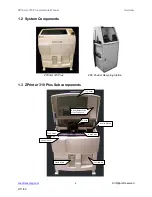
ZPrinter
®
310 Plus Hardware Manual
Overview
1
All Rights Reserved
2/11/09
1
Overview
Welcome to the exciting world of 3D Printing!
This manual will instruct you on how to take care of your printer and give you an introduction to 3D Printing.
In addition, you can find information about 3D printing and its many applications and techniques on our
3DP User Web site at
This Web site is tailored to both beginner and advanced customers. We recommend that you register
immediately to receive free, unlimited access to this excellent resource.
1.1 How the ZPrinter 310 Plus Works
Z Corporation 3D Printer processes are based on the Massachusetts Institute of Technology’s patented
3DP™ (Three-Dimensional Printing) technology.
The proprietary ZPrint Software first converts a three-dimensional design file (built using 3D CAD) into
cross-sections or slices that are between 0.0035" – .008" (0.0889 - 0.2032 mm) thick. The printer then
prints these cross-sections, one after another, from the bottom of the design to the top.
Inside the ZPrinter 310 Plus there are two pistons. In the diagram below the
feed piston
is on the left and is
shown in the ‘down’ position filled with powder. The
build piston
is the piston on the right, shown below in
the ‘up’ position. Also represented in the diagrams is the
roller
(drawn as a circle) and the
print assembly
(drawn as a square). On the printer, the roller and the print assembly are mounted together on the
gantry
which moves horizontally across the build area.
To begin the 3D printing process, the printer first spreads a layer of zp
®
series powder in the same thick-
ness as the cross section to be printed. The print head then applies a binder solution to the powder, caus-
ing the powder particles to bind to one another and to the printed cross-section one level below.
To print the next layer, the feed piston moves up and the build piston moves down, each by the thickness of
one layer. The roller then spreads the powder from the feed piston over onto the build piston, and the print
assembly prints the pattern of the next layer using binder.
The printer keeps repeating this same process over and over until a 3-dimensional part is created in the
powder.






































